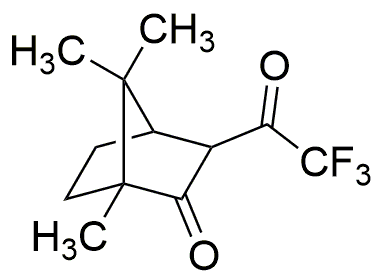(+)-3-(Trifluoroacetyl)camphor is widely utilized in research focused on:
- Pharmaceutical Development: This compound serves as an important intermediate in the synthesis of various pharmaceuticals, particularly in creating compounds with enhanced biological activity.
- Flavor and Fragrance Industry: Its unique scent profile makes it a valuable ingredient in the formulation of perfumes and flavorings, providing a fresh, camphoraceous note that is sought after in many products.
- Analytical Chemistry: Used as a chiral selector in chromatography, it helps in the separation of enantiomers, which is crucial for the development of chiral drugs and ensuring their efficacy and safety.
- Material Science: The compound is explored in the development of new materials, particularly in coatings and polymers, where its properties can enhance durability and resistance to environmental factors.
- Research in Organic Synthesis: It acts as a reagent in various organic reactions, facilitating the formation of complex molecules and aiding researchers in the exploration of new synthetic pathways.
General Information
Properties
Safety and Regulations
Applications
(+)-3-(Trifluoroacetyl)camphor is widely utilized in research focused on:
- Pharmaceutical Development: This compound serves as an important intermediate in the synthesis of various pharmaceuticals, particularly in creating compounds with enhanced biological activity.
- Flavor and Fragrance Industry: Its unique scent profile makes it a valuable ingredient in the formulation of perfumes and flavorings, providing a fresh, camphoraceous note that is sought after in many products.
- Analytical Chemistry: Used as a chiral selector in chromatography, it helps in the separation of enantiomers, which is crucial for the development of chiral drugs and ensuring their efficacy and safety.
- Material Science: The compound is explored in the development of new materials, particularly in coatings and polymers, where its properties can enhance durability and resistance to environmental factors.
- Research in Organic Synthesis: It acts as a reagent in various organic reactions, facilitating the formation of complex molecules and aiding researchers in the exploration of new synthetic pathways.
Documents
Safety Data Sheets (SDS)
The SDS provides comprehensive safety information on handling, storage, and disposal of the product.
Product Specification (PS)
The PS provides a comprehensive breakdown of the product’s properties, including chemical composition, physical state, purity, and storage requirements. It also details acceptable quality ranges and the product's intended applications.
Certificates of Analysis (COA)
Search for Certificates of Analysis (COA) by entering the products Lot Number. Lot and Batch Numbers can be found on a product’s label following the words ‘Lot’ or ‘Batch’.
*Catalog Number
*Lot Number
Certificates Of Origin (COO)
This COO confirms the country where the product was manufactured, and also details the materials and components used in it and whether it is derived from natural, synthetic, or other specific sources. This certificate may be required for customs, trade, and regulatory compliance.
*Catalog Number
*Lot Number
Safety Data Sheets (SDS)
The SDS provides comprehensive safety information on handling, storage, and disposal of the product.
DownloadProduct Specification (PS)
The PS provides a comprehensive breakdown of the product’s properties, including chemical composition, physical state, purity, and storage requirements. It also details acceptable quality ranges and the product's intended applications.
DownloadCertificates of Analysis (COA)
Search for Certificates of Analysis (COA) by entering the products Lot Number. Lot and Batch Numbers can be found on a product’s label following the words ‘Lot’ or ‘Batch’.
*Catalog Number
*Lot Number
Certificates Of Origin (COO)
This COO confirms the country where the product was manufactured, and also details the materials and components used in it and whether it is derived from natural, synthetic, or other specific sources. This certificate may be required for customs, trade, and regulatory compliance.


